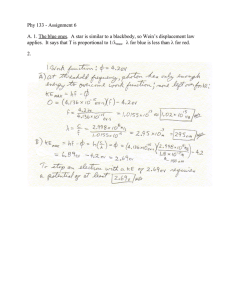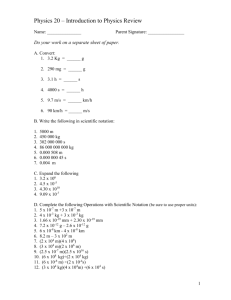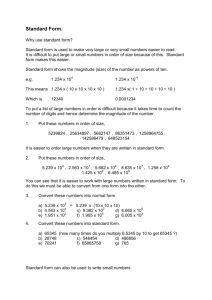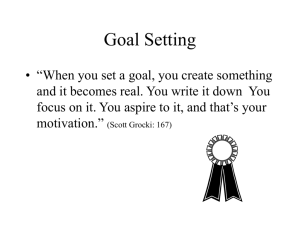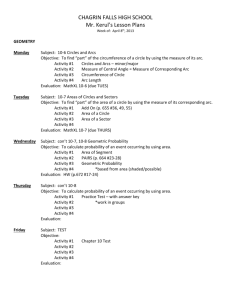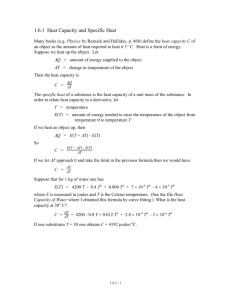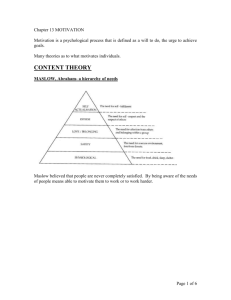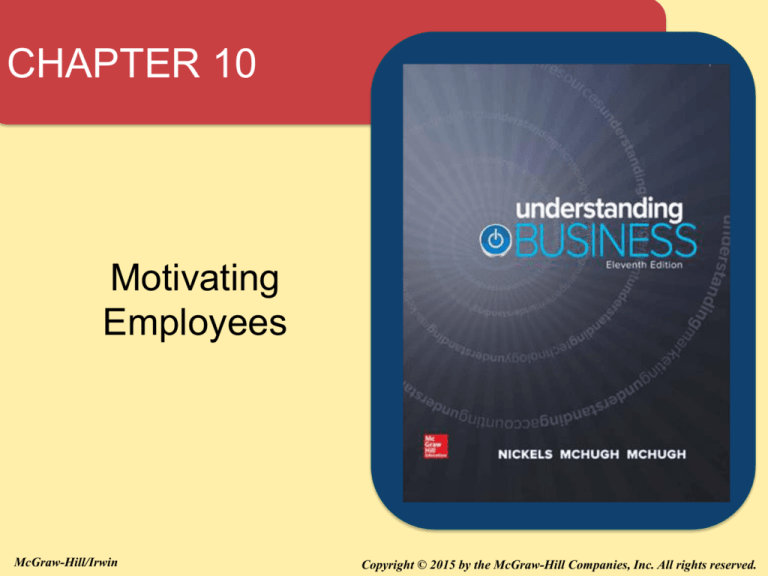
CHAPTER 10
Motivating
Employees
McGraw-Hill/Irwin
Copyright © 2015 by the McGraw-Hill Companies, Inc. All rights reserved.
LEARNING OBJECTIVES
1. Explain Taylor’s theory of scientific management.
2. Describe the Hawthorne studies and their
significance to management.
3. Identify the levels of Maslow’s hierarchy of needs
and apply them to employee motivation.
4. Distinguish between the motivators and hygiene
factors identified by Herzberg.
5. Differentiate among Theory X, Theory Y, and Theory
Z.
10-2
LEARNING OBJECTIVES
6. Explain the key principles of goal-setting,
expectancy, reinforcement, and equity theories.
7. Show how managers put motivation theories into
action through such strategies as job enrichment,
open communication, and job recognition.
8. Show how managers personalize motivation
strategies to appeal to employees across the globe
and across generations.
10-3
DAVID NOVAK
Yum Brands
• One of the largest food
companies, a restaurant is
opened every 14 hours.
• Novak stresses the
importance of his team of
employees worldwide.
• He is committed to growing
the company by boosting
employee morale.
10-4
NAME that COMPANY
Job enlargement combines a series of tasks into
one challenging and interesting assignment. This
home appliance manufacturer redesigned its
washing machine production process so that
employees could assemble an entire water pump
instead of just adding one part.
Name that company!
10-5
INTRINSIC REWARDS
• Intrinsic Rewards -- Personal satisfaction you feel
when you perform well and complete goals.
• Examples of
Intrinsic Rewards:
- Pride in your
performance
- Sense of
achievement
10-6
EXTRINSIC REWARDS
• Extrinsic Rewards -- Something given as a
recognition of good work.
• Kinds of Extrinsic Rewards:
- Pay Raises
- Promotions
- Awards
10-7
FRINGE BENEFITS
Perks Offered to Employees at Top 50 Employers
Source: Bloomberg BusinessWeek, www.businessweek.com, accessed November 2014.
10-8
TAYLOR’S SCIENTIFIC
MANAGEMENT
LO 10-1
• Scientific Management -- Studying workers to find
the most efficient ways of doing things and then
teaching people those techniques.
• Three Key Elements to Increase Productivity
1. Time
2. Methods of Work
3. Rules of Work
10-9
TAYLOR’S FOUR KEY
PRINCIPLES
LO 10-1
1. Study how a job is performed.
• Gather time & motion information.
• Check different methods.
2. Codify the best method into rules.
3. Choose workers whose skill matches the rules.
4. Establish a fair level of performance and pay.
10-10
TIME-MOTION STUDIES
LO 10-1
• Time-Motion Studies -- Studies of which tasks
must be performed to complete a job and the time
needed to do each task.
• Led to the development of the Principle of
Motion Economy -- Every job can be broken down
into a series of elementary motions; developed by
Frank and Lillian Gilbreth.
10-11
ARE YOU STRESSED?
LO 10-1
Warnings of Employee Stress
• Negative attitudes about work
• Drops in productivity
• Chronic lateness
• Absenteeism
• Careless with details
• Unable to work with others
• Withdrawal from co-workers
• Easily upset or angered
10-12
TAYLOR and UPS
LO 10-1
• UPS drivers work under strict rules and work
requirements.
• How to get out of their trucks:
- Right foot first
• How fast to walk:
- 3 ft per second
• How to hold their keys:
- Teeth up, third finger
10-13
HAWTHORNE STUDIES:
PURPOSE AND RESULTS
LO 10-2
• Researchers studied worker efficiency under
different levels of light.
• Productivity increased regardless of light
condition.
• Researchers decided it was
a human or psychological
factor at play.
• Hawthorne Effect -- People
act differently when they know
they are being studied.
10-14
MASLOW’S
THEORY of MOTIVATION
LO 10-3
• Hierarchy of Needs -- Theory of motivation
based on unmet human needs from basic
physiological needs to safety, social and esteem
needs to self-actualization needs.
• Needs that have already been met do not
motivate.
• If a need is filled, another higher-level need
emerges.
10-15
MASLOW’S
HIERARCHY of NEEDS
LO 10-2
10-16
HERZBERG’S
MOTIVATING FACTORS
LO 10-4
• Herzberg’s research centered on two questions:
- What factors controlled by managers are most
effective in increasing worker motivation?
- How do workers rank job-related factors in order
of importance related to motivation?
10-17
JOB CONTENT
LO 10-4
• Herzberg found job content
factors were most important
to workers – workers like to
feel they contribute to the
company.
• Motivators -- Job factors that
cause employees to be
productive and that give them
satisfaction.
10-18
JOB ENVIRONMENT
LO 10-4
• Job environment factors maintained satisfaction,
but did not motivate employees.
• Hygiene Factors -- Job
factors that can cause
dissatisfaction if missing but
that do not necessarily
motivate employees if
increased.
10-19
HERZBERG’S MOTIVATORS
and HYGIENE FACTORS
LO 10-4
10-20
COMPARISON of the THEORIES
of MASLOW and HERZBERG
LO 10-4
10-21
REIGNITE EMPLOYEES’ DRIVE
LO 10-4
Simple Ways to Reinvigorate Work Life
1. Don’t work alone all the
time; partners or teams
make work more efficient
and fun.
2. Redecorate your space to
get away from the sameold, same-old.
3. Don’t complain; think of
things to celebrate.
Photo Credit: Nels Highberg
Source: Fast Company, www.fastcompany.com, accessed November 2014.
10-22
TEST PREP
• What are the similarities and differences between
Taylor’s time-motion studies and Mayo’s
Hawthorne studies?
• How did Mayo’s findings influence scientific
management?
• Draw a diagram of Maslow’s hierarchy of needs.
Label and describe the parts.
• Explain the distinction between what Herzberg
called motivators and hygiene factors.
10-23
THEORY X and THEORY Y
LO 10-5
• Douglas McGregor proposed managers had two
different sets of assumptions concerning workers.
• Their attitudes about motivating workers were tied
to these assumptions.
• McGregor called them Theory X and Theory Y.
10-24
ASSUMPTIONS of
THEORY X MANAGERS
LO 10-5
• Workers dislike work and
seek to avoid it.
• Workers must be forced or
threatened with punishment
to get them to perform.
• Workers prefer to be directed
and avoid responsibility.
• Primary motivators are fear
and punishment.
10-25
ASSUMPTIONS of
THEORY Y MANAGERS
LO 10-5
• People like work, it’s a part of life.
• Workers seek goals to which they are committed.
• Commitment to goals depends on perceived
rewards.
• People can use creativity to solve problems.
• Intellectual capacity is only partially realized.
• People are motivated by a variety of rewards.
10-26
THEORY Z
LO 10-5
• William Ouchi researched cultural differences
between the U.S. (Type A) and Japan (Type J).
• Type J committed to the organization and group.
• Type A focused on the
individual.
• Theory Z is the hybrid
approach of Types A
and J.
10-27
THEORY Z
LO 10-5
10-28
THEORY COMPARISIONS
LO 10-5
10-29
GOAL-SETTING THEORY
LO 10-6
• Goal-Setting Theory -Setting ambitious but
attainable goals can motivate
workers and improve
performance if the goals are
accepted, accompanied by
feedback, and facilitated by
organizational conditions.
10-30
APPLYING GOAL-SETTING
THEORY
LO 10-6
• Management by Objectives (MBO) -- Involves a
cycle of discussion, review and evaluation of
objectives among top and middle-level managers,
supervisors and employees.
• Managers formulate goals in cooperation with
everyone in the organization.
• Need to monitor results and reward achievement.
10-31
LO 10-6
WHAT is MBO?
Set organizational objectives
Reward
performance
Link objectives to
employee’s goals
Evaluate
performance
Monitor
Source: Bloomberg Business Week, accessed November 2014.
10-32
ORGANIZATIONS USING MBO
LO 10-6
• Toyota Motor Company
• Emerson Electric Company
• U.S. Department of Defense
10-33
EXPECTANCY THEORY in
MOTIVATION
LO 10-6
• Expectancy Theory -- The amount of effort
employees exert on a specific task depends on their
expectations of the outcome.
• Employees ask:
- Can I accomplish the task?
- What’s my reward?
- Is the reward worth the effort?
• Expectations can vary from person to person.
10-34
EXPECTANCY THEORY
LO 10-6
10-35
NADLER & LAWLER’S
MODIFICATION
LO 10-6
• Researchers Nadler and Lawler modified
expectancy theory and suggested five steps for
managers:
1. Determine what rewards employees value.
2. Determine workers’ performance standard.
3. Make sure performance standards are attainable.
4. Tie rewards to performance.
5. Be sure employees feel rewards are adequate.
10-36
USING
REINFORCEMENT THEORY
LO 10-6
• Reinforcement Theory -- Positive and negative
reinforcers motivate a person to behave in certain
ways.
• Positive reinforcement includes praise, pay
increases and recognition.
• Negative reinforcement occurs when people work
to escape punishment (reprimands, reduced pay,
and layoff or firing).
• Extinction is a way of trying to stop behavior by
not responding to it.
10-37
EQUITY THEORY
LO 10-6
• Equity Theory -- Employees try to maintain equity
between inputs and outputs compared to others in
similar positions.
• Workers often base perception of their outcomes
on a specific person or group.
• Perceived inequities can lead to reduced quality
and productivity, absenteeism, even resignation.
10-38
TEST PREP
• Briefly explain the managerial attitudes behind
Theories X, Y and Z.
• Explain goal-setting theory.
• Evaluate expectancy theory. When could
expectancy theory apply to your efforts or lack of
effort?
• Explain the principles of equity theory.
10-39
ENRICHING JOBS
LO 10-7
• Job Enrichment -- A motivational strategy that
emphasizes motivating the worker through the job
itself.
• Based on Herzberg’s
motivators, such as
responsibility,
achievement and
recognition.
10-40
MOTIVATION on a BUDGET
LO 10-7
Tactics of Today’s HR Managers
Source: Wall Street Journal, March 1, 2010.
10-41
KEY CHARACTERISTICS
of WORK
LO 10-7
1. Skill Variety
2. Task Identity
3. Task Significance
4. Autonomy
5. Feedback
10-42
TYPES of JOB ENRICHMENT
LO 10-7
• Job Enlargement -- A job enrichment strategy
that involves combining a series of tasks into one
challenging and interesting assignment.
• Job Rotation -- A job enrichment strategy that
involves moving employees from one job to
another.
10-43
ENRICHMENT
by WAY of FLEXIBILITY
LO 10-7
• 60% of employees think they can be productive and
efficient outside of the office.
• 66% of employees would take a lower-paying job if it
came with more flexibility.
• 59% of employees say their company doesn’t have a
formal out-of-office work policy.
Source: Entrepreneur, www.entrepreneur.com, accessed November 2014.
10-44
USING OPEN COMMUNICATION
LO 10-7
• Create a culture that
rewards listening.
• Train managers to listen.
• Use effective questioning
techniques.
• Remove barriers to open
communication.
• Ask employees what’s
important to them.
10-45
WHEN is SOCIAL MEDIA
TOO SOCIAL?
• Sites like Facebook are banned in 20% of
workplaces.
• Some argue this is a bad idea because:
1. It alienates younger employees.
2. It suggests businesses don’t trust employees.
3. It can make employees feel disengaged.
4. It takes away an element of relaxation.
10-46
WHEN TOO MUCH is TOO MUCH
24/7 Access Isn’t Always a Good Thing
• Schedule correspondence:
-
Don’t check email whenever it arrives, schedule times to check.
• Pick one task:
-
Having too much open at once takes attention away from
singular tasks.
• Don’t answer the phone:
-
Don’t be afraid of voicemail.
• Maintain human contact:
-
Don’t look at your computer or phone while someone is at your
desk. Keep attention (and respect!) on them.
Source: Entrepreneur, www.entrepreneur.com, accessed November 2014.
10-47
RECOGNIZING GOOD WORK
LO 10-7
• Raises are not the only ways to recognize an
employee’s performance. Recognition can also
include:
- Paid time off
- Flexible scheduling
- Work from home opportunities
- Paid child or elder care
- Stock options or profit sharing
- Company awards
- Company events or teams
10-48
WORK WELL with OTHERS
LO 10-7
Keys for Productive Teamwork
• Have a common
understanding of your
task.
• Clarify roles and
responsibilities.
• Set rules.
• Get to know each
other.
• Communicate openly
and often.
10-49
WHAT’S GOOD for YOU
LO 10-7
Most Positive Remedies for Employee Moral
10-50
WHAT’S BAD for YOU
LO 10-7
Most Negative Actions for Employee Morale
10-51
GOING UP AGAINST
the HEAVYWEIGHTS
• Sparta Systems employees
play video games during
breaks.
• Bigcommerce offers
bootcamps with a trainer.
• Zoosk allows employees to
bring dogs to work.
• Shift Communications has
recess
10-52
MOTIVATING EMPLOYEES
ACROSS the GLOBE
LO 10-8
• Cultural differences make worker motivation a
challenging task for global managers.
• High-Context cultures require relationships and
group trust before performance.
• Low-Context cultures
believe relationship
building distracts from
tasks.
10-53
BEYOND JUST KNOWING
CROSS-CULTURE DIFFERENCES
• A better understanding of cultures helps
managers increase customer satisfaction and
loyalty.
• It is more than just knowing other languages, it’s
knowing what’s proper.
• IBM works closely with many different people
before entering new markets.
10-54
MOTIVATING ACROSS the
GENERATIONS
LO 10-8
• Baby Boomers (1946 – 1964)
- Experienced great economic prosperity, job
security, optimism about their future
• Generation X (1965 – 1980)
- Raised in dual-career families, attended day care,
feeling of insecurity about jobs
• Generation Y or Millennials (1980 – 1995)
- Raised by indulgent parents, used to many
comforts like computers and cell phones
10-55
UPCOMING GENERATIONS
in the WORKPLACE
LO 10-8
• Generation Z (1996 – 2009)
- Grew up post 9/11, in the wake of the Great
Recession and amid many reports of school
violence
• Generation Alpha (after 2010)
10-56
GENERATION X in the
WORKPLACE
LO 10-8
• Desire economic security but focus more on
career security than job security.
• Good motivators as managers due to emphasis
on results rather than work hours.
• Tend to be flexible and good at collaboration and
consensus building.
• Very effective at giving employee feedback and
praise.
10-57
MILLENNIALS and the
WORKPLACE
LO 10-8
• Tend to be impatient, skeptical, blunt and
expressive.
• Are tech-savvy and able to grasp new concepts.
• Able to multi-task and are efficient.
• Highlight a strong sense of commitment.
• Place a high value on work-life balance.
• Fun and stimulation are key job requirements.
10-58
COMMUNICATION
ACROSS the GENERATIONS
LO 10-8
• Baby Boomers (1946 – 1964)
- Prefer meetings and conference calls.
• Generation X (1965 – 1980)
- Prefer email and will choose meetings only if there
are no other options.
• Generation Y or Millennials (1980 – 1995)
- Prefer to use technology to communicate,
particularly through social media.
10-59
The BEST COMPANIES for
WORKERS
Company
Location
Google
Mountain View, California
SAS
Cary, North Carolina
Boston Consulting Group
Boston, Massachusetts
Edward Jones
St. Louis, Missouri
Quicken Loans
Detroit, Michigan
Genentech
San Francisco, California
Source: Fortune, www.fortune.com, accessed November 2014.
LO 10-8
10-60
TEST PREP
• What are several steps firms can take to increase
internal communications and thus motivation?
• What problems may emerge when firms try to
implement participative management?
• Why is it important to adjust motivational styles to
individual employees? Are there any general
principles of motivation that today’s managers
should follow?
10-61

